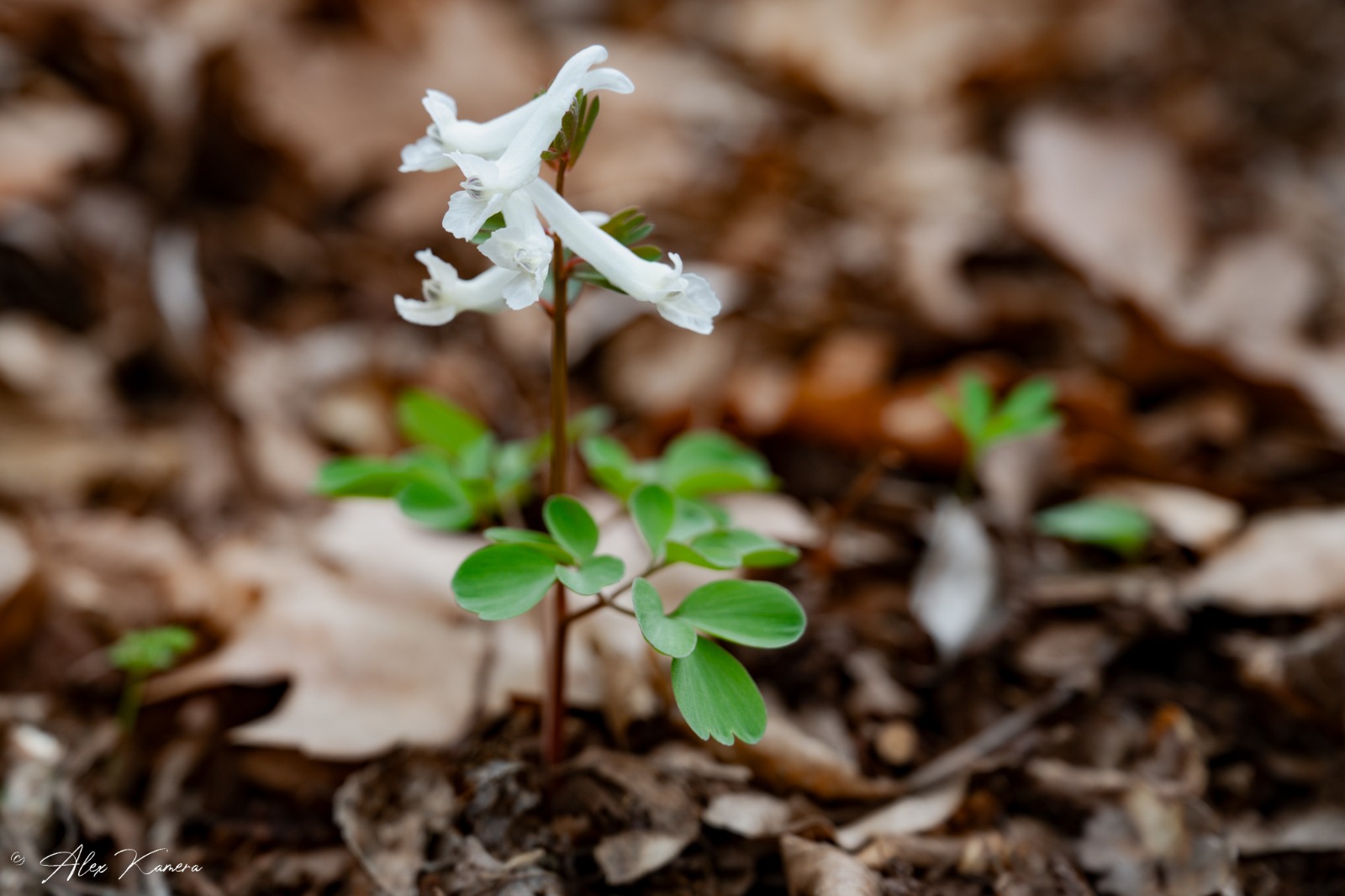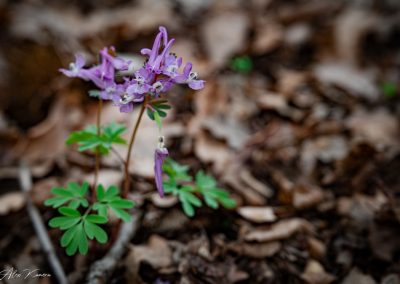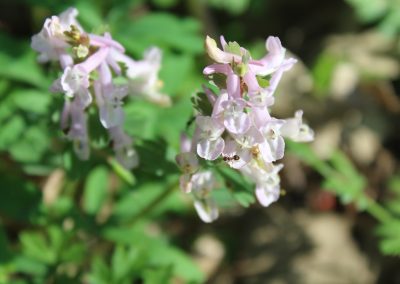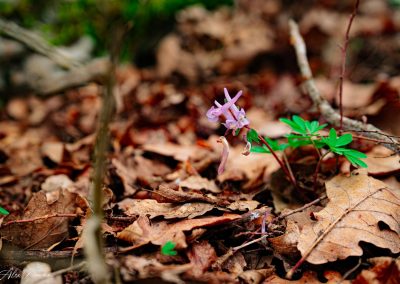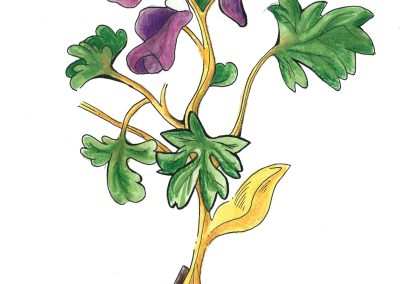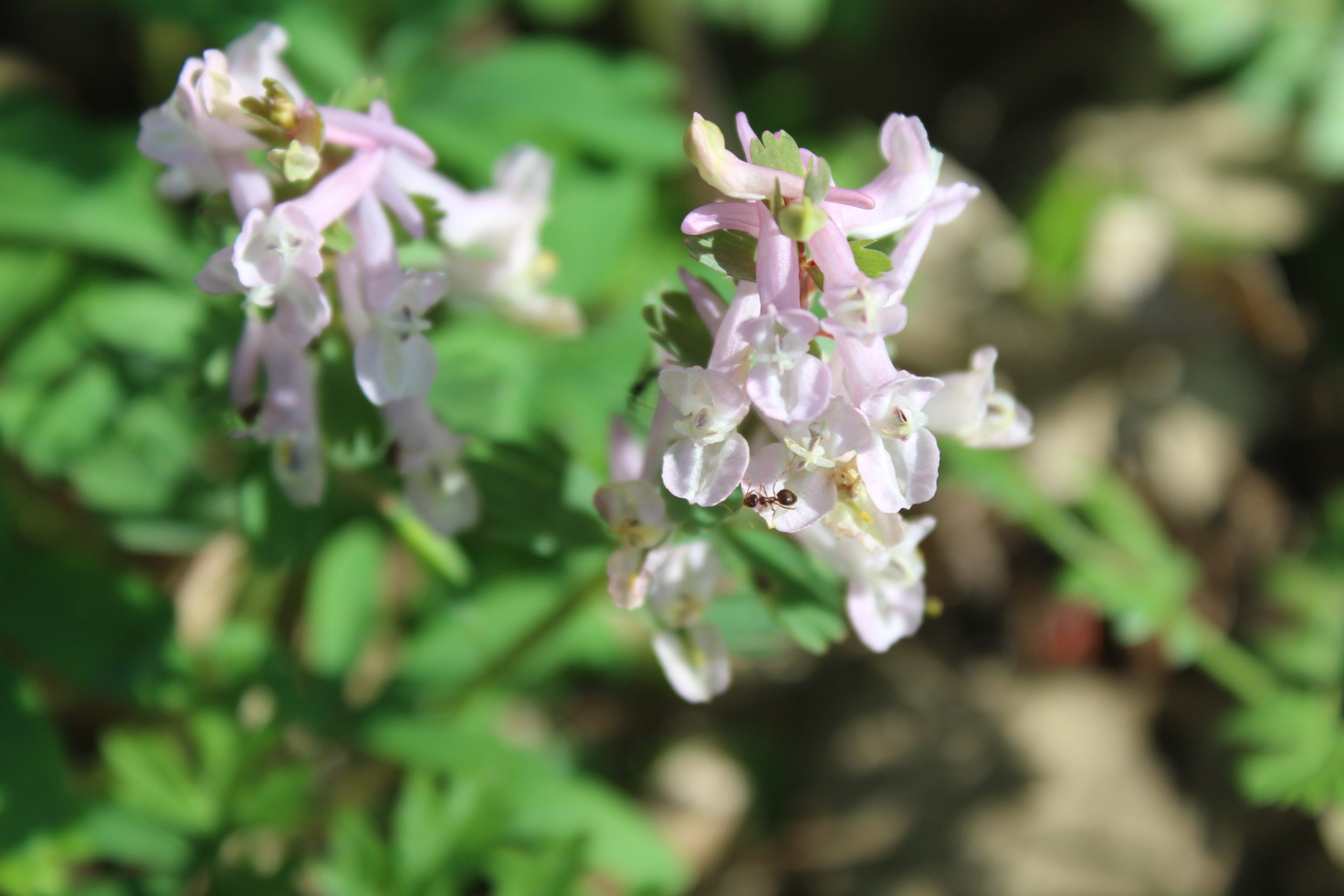Corydalis solida
Scientific description
Taxon: Angiospermatophyta (Magnoliophyta)
Class: Dicotyledonatae (Magnoliatae)
Subclass: Magnoliidae (Polycarpicae)
Order: Papaverales
Family: Fumariaceae
Common name: Corydalis
Origin: Northern Europe
Description:
It is a perennial, vernal herbaceous plant. With well-developed, hard, and compact bulbs. The stem is succulent, fleshy, erect, unbranched, and rarely exceeds 20cm in height, green or reddish-brown in color. Sometimes two stems can develop from the same rhizome. The stem leaves are usually in pairs and petiolate. The inflorescence is a simple, erect, terminal raceme, usually multiflowered, dense. The purple flowers - with a short, curved spur, the upper lip twisted at the edge - are numerous. It blooms in March-April. The fruit is an ovate-lanceolate capsule, 1-3cm long. The seeds are globose, black, shiny.
Propagation: seeds or bulbs.
Ecology:
Common from the plain to the mountain areas, in meadows, shrubs. It loves shade and thrives on rocky slopes with moderate nitrogen soils.
Use:
It is a toxic plant, due to bulbocapnine, it also contains active substances such as corydaline, corycavine. The bulbs are used medicinally. Preparations from corydalis have an action on the nervous system, they are also used to help with heart conditions, but they also help the gastrointestinal tract. Juice can be obtained from the stems and flowers. It is also an ornamental plant, with horticultural importance, used for landscaping courtyards, gardens.
Threat: As a medicinal plant, Corydalis is little known in our country. It is a native species, mentioned in the Red List of superior plants in Romania (Oltean et al., 1994). Currently, the species is threatened by the replacement of grasslands and shrubs with arable land and grazing.
Încrengătura: Angiospermatophyta (Magnoliophyta)
Clasa: Dicotyledonatae (Magnoliatae)
Subclasa: Magnoliidae (Polycarpicae)
Ordinul: Papaverales
Familia: Fumariaceae
Denumire populară: brebenel
Originea: nordul Europei.
Descrierea:
este o erbacee perenă, vernală. Cu bulbi dezvoltați, gol pe dinăuntru. Tulpina este suculentă, cărnoasă, erectă, neramificată și rareori trece de 20 cm înălțime, de culoare verde sau brun-roșcată, uneori se pot dezvolta câte două din același rizom. Frunzele tulpinale de regulă sunt câte 2 și pețiolate. Inflorescența este un racem simplu, erect, terminal, erect, de regulă multiflor, dens. Florile purpurii – pinten scurt, curbat, buza superioară la margine răsucită, sunt numeroase. Înflorește în lunile martie-aprilie. Fructul este o capsulă ovat lanceolată, lungă de 1-3cm. Semințele sunt globuloase, negre, lucioase.
Înmulțire: semințe sau bulbi.
Ecologie:
frecventă din zona de câmpie până în zonele de munte, prin pajişti, tufărişuri. Este o plantă umbrofilă, vegetează foarte bine pe coaste pietroase, cu soluri moderate în azot.
Utilizare:
este o plantă toxică, datorită bulbocapninei, mai conține și substanțe active ca coridalină, coricavină. Se întrebuințează medicinal bulbii. Preparatele din brebenel au acțiune asupra sistemului nervos, se folosesc și în afecțiuni cardiace, dar ajută și tractului gastrointestinal. Din tulpini și flori se poate obține un suc. Este și o plantă ornamentală, cu importanță horticolă, pentru amenajarea curților, grădinilor.
Pericol: ca plantă medicinală brebenelul este puțin cunoscut în țara noastră. Este o specia autohtonă, menționată în Lista Roșie a plantelor superioare din România (Oltean și colab. 1994). În prezent specia este amenințată de înlocuirea pajiștilor și a tufărișurilor cu terenuri arabile și de pășunat.
Γένος: Angiospermatophyta (Magnoliophyta)
Τάξη: (Magnoliatae)
Υποκατηγορία: Magnoliidae (Polycarpicae)
Τάξη: Papaverales
Οικογένεια: Fumariaceae
Δημοφιλής ονομασία: ρείκι
Καταγωγή: Βόρεια Ευρώπη.
Περιγραφή:
Είναι πολυετές, ποώδες, εαρινό βότανο. Με ανεπτυγμένους βολβούς, κούφιους στο εσωτερικό τους. Ο βλαστός είναι χυμώδης, σαρκώδης, όρθιος, μη διακλαδισμένος και σπάνια έχει ύψος πάνω από 20 εκατοστά, πράσινο ή κοκκινωπό-καφέ χρώμα, μερικές φορές μπορεί να αναπτυχθούν δύο από το ίδιο ρίζωμα. Τα φύλλα του βλαστού είναι συνήθως 2 και μίσχο. Η ταξιανθία είναι μια απλή, όρθια, τερματική, όρθια, συνήθως πολύφυλλη, πυκνή τσαμπιά. Τα πορφυρά άνθη - κοντό, καμπύλο σπιρούνι, το άνω χείλος στην άκρη στριμμένο, είναι πολυάριθμα. Ανθίζει τον Μάρτιο-Απρίλιο. Ο καρπός είναι μια ωοειδής λογχοειδής κάψουλα, μήκους 1-3 εκατοστών. Οι σπόροι είναι σφαιρικοί, μαύροι, γυαλιστεροί.
Πολλαπλασιασμός: σπόροι ή βολβοί.
Οικολογία:
κοινό από τις πεδινές περιοχές έως τα βουνά, σε λιβάδια, θαμνώνες. Είναι ομβροφιλικό φυτό, αναπτύσσεται πολύ καλά σε βραχώδεις πλαγιές με εδάφη μέτριας περιεκτικότητας σε άζωτο.
Χρήση:
είναι ένα τοξικό φυτό, λόγω της βολβοκαπνίνης, περιέχει επίσης δραστικές ουσίες όπως η κοριδαλίνη, η κορικαβίνη. Οι βολβοί χρησιμοποιούνται φαρμακευτικά. Τα παρασκευάσματα Brebenel έχουν δράση στο νευρικό σύστημα, χρησιμοποιούνται επίσης σε καρδιακές παθήσεις, αλλά βοηθούν και το γαστρεντερικό σύστημα. Από τα στελέχη και τα άνθη μπορεί να ληφθεί χυμός. Είναι επίσης ένα καλλωπιστικό φυτό, με κηπευτική σημασία, για τη διαμόρφωση του τοπίου.
Κίνδυνος: ως φαρμακευτικό φυτό, η ερείκη είναι ελάχιστα γνωστή στη χώρα μας. Πρόκειται για αυτοφυές είδος, που αναφέρεται στον Κόκκινο Κατάλογο των ανώτερων φυτών της Ρουμανίας (Oltean et al. 1994). Σήμερα το είδος απειλείται από την αντικατάσταση των λιβαδιών και των θαμνώνων από καλλιεργήσιμες και βοσκότοπους.
Taxon : Angiospermatophyta (Magnoliophyta)
Classe : Dicotylédones (Magnoliatae)
Sous-classe : Magnoliidae (Polycarpicae)
Ordre : Papaverales
Famille : Fumariacées (Fumariaceae)
Nom commun : Corydale
Origine : Europe du Nord
Description :
C’est une plante herbacée vivace et printanière. Elle possède des bulbes bien développés, durs et compacts. La tige est succulente, charnue, dressée, non ramifiée et dépasse rarement 20 cm de hauteur. Sa couleur varie du vert au brun rougeâtre. Parfois, deux tiges peuvent se développer à partir du même rhizome. Les feuilles de la tige sont généralement disposées par paires et sont pétiolées. L’inflorescence est une grappe terminale simple, dressée, généralement multi fleurie et dense. Les fleurs, de couleur pourpre, sont nombreuses et possèdent un court éperon courbé ainsi qu'une lèvre supérieure torsadée sur les bords. La floraison a lieu en mars-avril. Le fruit est une capsule ovée-lancéolée mesurant de 1 à 3 cm de long. Les graines sont globuleuses, noires et brillantes.
Multiplication : Par graines ou bulbes.
Écologie :
Espèce commune des plaines jusqu’aux zones montagneuses, poussant dans les prairies et les fourrés. Elle apprécie l’ombre et prospère sur les pentes rocheuses présentant des sols modérément riches en azote.
Utilisation :
Cette plante est toxique en raison de la présence de bulbocapnine, mais elle contient aussi des substances actives comme la corydaline et la corycavine. Les bulbes sont utilisés en médecine. Les préparations à base de corydale agissent sur le système nerveux et sont aussi employées pour traiter les affections cardiaques et les troubles gastro-intestinaux. Il est possible d’extraire du jus de ses tiges et de ses fleurs. Elle constitue également une plante ornementale ayant une importance horticole et est utilisée pour l’aménagement des cours et des jardins.
Menaces : En tant que plante médicinale, la corydale est peu connue dans notre pays. Il s’agit d’une espèce indigène mentionnée dans la Liste rouge des plantes supérieures de Roumanie. Actuellement, elle est menacée par la conversion des prairies et des fourrés en terres arables et zones de pâturage.
Creative writing inspired by Corydalis Solida
Written by Andreea Tote
The Love from the Sunken Monastery
On the outskirts of the village of Remetea, there once stood a monastery, a sanctuary for a community of monks. Whenever the three rivers—Tisza, Tur, and Someș—overflowed simultaneously, with their waters uncontrolled at the time, the monastery would become completely isolated from the surrounding inhabited areas for long periods.
Near the monastery, in an ancient oak forest, grew the brebenel—a delicate and discreet flower. As it developed, it would unfold its slender leaves in a vibrant, fresh shade of green. Its small, fragile blossoms displayed soft pastel hues of pink and purple, creating a graceful and refined visual spectacle. Upon first encounter, its subtle fragrance would gently envelop your senses, offering a moment of enchantment, as if in a magical garden.
Legend has it that this garden was born from the tragic love between an orphan girl, skilled in the healing arts of medicinal plants, and a young man of noble descent—perhaps even a prince. Though their love was genuine, it was never accepted. After their death, white brebenel bloomed from the girl's grave, a symbol of purity and sorrow, while violet brebenel grew from the boy's grave, a sign of longing and unfulfilled love.
The monastery itself did not escape a tragic fate. Repeated floods saturated the ground so thoroughly that, one day, the building collapsed and was swallowed by the waters. It is said that until the very last moment, a monk rang the bell without pause. Even today, legends say that every seventh year, the tolling of that bell can still be heard echoing from the depths.
And the young lovers? It is believed that they, too, continue their love beyond time, meeting again and again in the form of the delicate brebenel flowers that bloom each spring— a silent reminder of a love that never ended.


